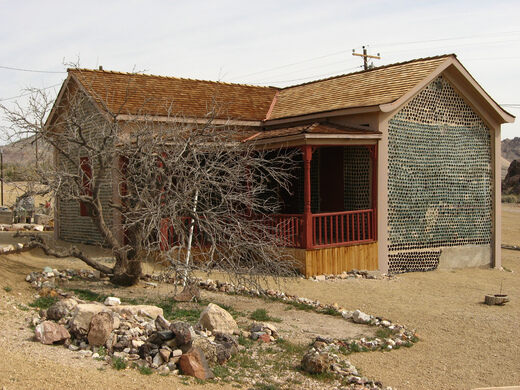


Today, just two buildings remain fully intact, one of which is the first one you’ll spot as you drive into town – Tom Kelly’s Bottle House. Tom Kelly built this iconic structure in 1906, from 51,000 beer bottles, adobe and mud. At one time it housed a curio shop, but today it remains behind a locked gate to protect it from vandals. There is accessible parking in front of the house, and sidewalk access up to the house, so it’s definitely worth a stop. There’s also a small kiosk that has maps of Rhyolite, so be sure to get one before you leave.
ONE OF AMERICA’S MOST PECULIAR ghost towns, Rhyolite, Nevada is uniquely rich in one thing: bottle houses. Three of these structures–made by embedding glass beverage bottles in various kinds of mortar–can be found in this long-dead desert town.
A marvel in its own right, the standout among these glass houses was built by a man named Tom Kelly. Like so many others, Kelly had been drawn to the West by the promise of gold. Around the year 1905, Kelly chose Nevada’s Bullfrog Hills as the site where he would finally put down his pan and build a home. In the mining camp of Rhyolite, where the only source of lumber was the ill-suited Joshua tree, Kelly saw construction potential at the bottom of his beer bottle.
With an estimated 50 saloons operating in Rhyolite at the time, Kelly collected 50,000 bottles in less than six months, enough to build a three-room house, complete with a porch and quaint gingerbread trim. Inside, the walls were plastered like a real city home. To miners of the day, this was a castle.
Already approaching 80 years old, Kelly declined to live in the home he’d built, and instead capitalized on the hubbub. Upon its completion in February of 1906, Kelly raffled off the bottle house for $5 per ticket. The house was won by the Bennet family, who lived inside until 1914. By 1920, the boomtown had gone bust, and a mere 20 residents remained in Rhyolite. In 1925, the bottle house got a facelift in the form of a new roof when Paramount Pictures used it for a movie set. It was converted into a museum of sorts after filming. From 1936 until 1954, Lewis Murphy was the Bottle House’s resident caretaker, providing tours for all interested visitors. After his departure, the bottle house’s final inhabitants were Tommy Thompson and his family, including eight children, who lived there until 1969 and added the miniature houses that can still be seen scattered across the lawn to this day.
The most magnificent bottle house in a town strangely full of them.

